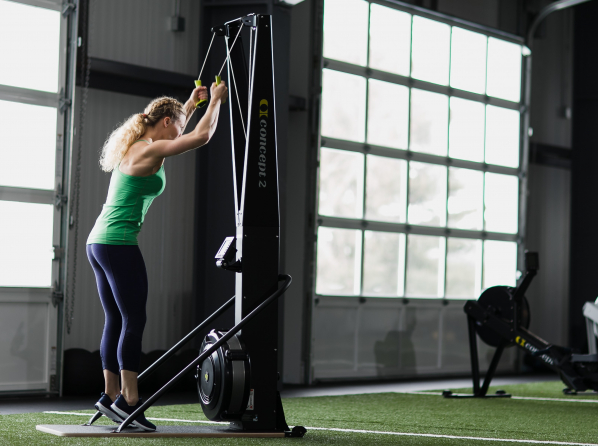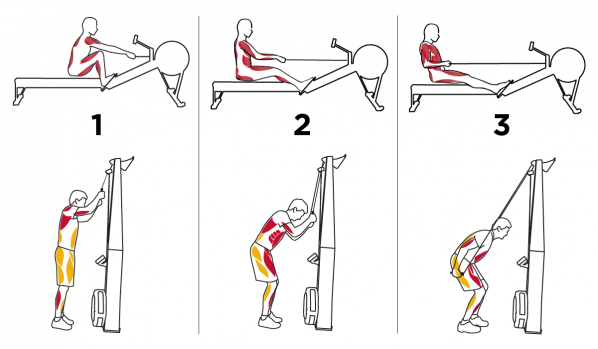SkiErg—the Complementary Workout
 The Concept2 SkiErg® may be a different kind of exercise machine than what you're used to, but this difference is precisely why the SkiErg can complement so many other forms of training so effectively.
The Concept2 SkiErg® may be a different kind of exercise machine than what you're used to, but this difference is precisely why the SkiErg can complement so many other forms of training so effectively.
The motion of skiing involves a crunch of the core, bending at the knees, and a full range of work with the arms, from overhead down to the sides of the thighs. In a prior blog, we discuss the fact that this motion is highly complementary to the motion of rowing. Rowing opens at the hips, while skiing closes. Rowing finishes the stroke with legs straight and arms pulled in; skiing finishes a “stroke” with legs compressed, and arms extended. One works the anterior chain, the other works the posterior chain. The two exercises complement each other nicely.

How Can the SkiErg Benefit Rowers?
There are several benefits to using the SkiErg to complement your existing exercise routine.
- The variety of motion can help avoid specific muscle fatigue. Even if rowing (indoor or on water) is your primary sport, you may not make optimal progress if you just row all the time.
- Complementary movements can build more balanced strength and endurance in the muscles used.
- One more benefit is the added range of motion achieved, especially with the arms.
How the SkiErg can Complement Your Training
If you’re not specifically training for rowing, you may be more interested in a different type of complementarity—basically just using different muscle groups from the majority of your exercise. Say you do a lot of running, cycling, hiking, walking, or functional fitness activities—these are all heavily focused on lower body endurance and strength. The SkiErg works the legs, too—but just as importantly, it will add a healthy dose of upper body and core work to your training. Several SkiErg workouts per week will complement your leg-based exercise routines nicely. In fact, the SkiErg movement—based on the Nordic skiing double-pole motion—is one of the few sport motions that builds upper body endurance while still providing a full-body, low-impact workout.
The SkiErg also works really well as an addition to workouts like weight circuits or CrossFit® WODs, where quick transitions between exercises are key. You may be rotating between core work on the floor, standing lifts with a bar, burpees, air squats, etc. When it’s time for the SkiErg, all you need to do is grab the handles and go.
"It's easy to just pop on there, do a few minutes of high intensity skiing, and then just pop off."—Chris A., from the SkiErg Facebook group
Whatever your workout plan is, it's easy to integrate the SkiErg:
- HIIT workouts: High-intensity interval training is great fun, using the SkiErg alone or in combination with other movements.
- Endurance: the SkiErg is great for long pieces, or combine rowing and skiing into a single workout.
- Cross-Training: Athletes from a wide variety of sports cross-train on the SkiErg during their training season.
The SkiErg for Skiers
Most skiers include outdoor training in the summer but there are also good reasons to keep some SkiErg time in the mix. The PM5 gives consistent quantitative information on your performance—something that’s not easy to get in many outdoor activities—so it's a really good way to track your progress. At any time of year, when the weather doesn't cooperate, the snow isn't ready yet, roads are unsafe for roller skiing or you need a good indoor warm-up for a strength workout, the SkiErg is always there to complement your outdoor training.
It comes down to the fact that the SkiErg is different from so many other forms of training, which means it can complement them nicely. Step up to a SkiErg, have a pull, and see what you think.
